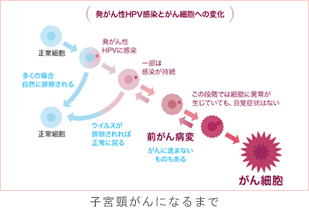
What is cervical cancer?
Cervical cancer is a preventable cancer.
Acquire the correct knowledge and protect your precious body.
What kind of disease is cervical cancer?
The uterus is one of the special organs that only women have. Cancer that develops in the cervix, which is near the entrance of the uterus, is called cervical cancer.
If you are diagnosed with cervical cancer, you may have to have your uterus and the organs around it removed. Even if you are a woman who does not want to become pregnant or give birth, you will lose a lot, including aftereffects that will affect your work and life. Furthermore, if the cancer progresses further, it may have a serious impact on your life itself. However, cervical cancer is a preventable cancer, and the causes and process of cancer are largely understood. Also, by undergoing regular health checkups, it is possible to detect it before it becomes cancer and treat it without losing your uterus.

Cervical cancer is a disease that can affect any woman.
When we hear the word "cancer," we may think of it as something that is likely to occur if someone in a close family or relative has had cancer. However, cervical cancer is a disease that can occur in any woman who has had sexual intercourse, regardless of heredity.
In recent years, the incidence rate has increased among young women, from the late 20s to 30s. Cervical cancer is the third leading cause of cancer deaths and the second leading cause of cancer specific to women after breast cancer. It is the leading cause of all cancers, especially among women in their 3s and 2s.
Additionally, 27 women around the world lose their precious lives to cervical cancer every year. This translates to one death every two minutes. In Japan, 2 women are diagnosed with cervical cancer each year (including intraepithelial carcinoma).


Cervical cancer is mostly asymptomatic
Cervical cancer often has no symptoms in the early stages, and women are unable to detect it on their own. Therefore, by the time women notice irregular bleeding, increased vaginal discharge, or bleeding during intercourse, the cancer has often progressed. If the cancer progresses, surgery to remove the entire uterus may be necessary, which will eliminate the possibility of pregnancy and childbirth, placing a heavy burden on women both physically and mentally. Furthermore, if the cancer has spread to the surrounding organs, it may be necessary to remove not only the uterus, but also the surrounding organs such as the ovaries and lymph nodes, which can be life-threatening.

Symptoms of advanced cervical cancer
Bleeding after intercourse, abnormal vaginal discharge (increased brown or dark brown vaginal discharge, etc.),
Irregular bleeding (bleeding outside of menstruation), pain in the lower abdomen or lower back
Cervical cancer is caused by a virus
Unlike other cancers, the cause of cervical cancer has been identified. It has been revealed that almost 100% of cervical cancer cases are caused by infection with a virus called human papillomavirus (HPV). Carcinogenic HPV, which causes cervical cancer, is a virus that is transmitted through skin-to-skin (mucous membrane) contact, and is thought to be transmitted in many cases through sexual intercourse. Carcinogenic HPV is such a common virus that it has been reported that approximately 80% of all women are infected with it at least once in their lifetime. For this reason, all women who have sexual activity have the potential to develop cervical cancer.

To prevent cervical cancer, vaccination and regular checkups are required.
The cervical cancer prevention vaccine can prevent infection with two carcinogenic HPV strains, HPV types 16 and 18. However, it does not prevent infection with all carcinogenic HPV types. In order not to overlook these abnormalities, it is necessary to undergo regular cervical cancer screening even after receiving the vaccine.
Cervical Cancer Q&A
- What is the difference between cervical cancer and uterine cancer?
Cancer that develops in the "cervix" near the entrance of the uterus is called "cervical cancer," while cancer that develops in the "corpus uteri" deep inside the uterus, where the baby grows, is called "uterine cancer." These are the two main types of uterine cancer.
- What causes cervical cancer?
Cervical cancer is caused by infection with a virus called human papillomavirus (HPV). It is mainly transmitted through sexual intercourse, but regardless of genetics, anyone who has had sexual intercourse can be infected with HPV.
- Is there anything I can do to prevent cervical cancer?
Cervical cancer can be prevented by getting the HPV vaccine and undergoing regular cervical cancer screening every one to two years.
- Does the test hurt?
Although the pain sensation varies from person to person, it is almost painless. The cervical cancer screening itself takes only about 5 minutes. It is called a cytology (Pap test), and cells from the cervix are scraped with a small spatula or brush and examined under a microscope to see if there are any abnormal cells that appear when HPV is infected.
- My uterine cancer screening result said I need further examination. Does that mean I have cervical cancer?
As a result of a cervical cancer screening, only about 1% of people undergoing a detailed examination will need to undergo a detailed examination. Furthermore, only a small proportion of people who undergo a detailed examination will actually be found to have cervical cancer, so "requiring detailed examination" does not necessarily mean "cervical cancer." If abnormal cells are found in the "cytology" of a cervical cancer screening test, a detailed examination will be required to examine the condition of the cells in more detail.
The detailed examination involves a colposcopy and a tissue biopsy.
- HPV refers to the human papillomavirus.


